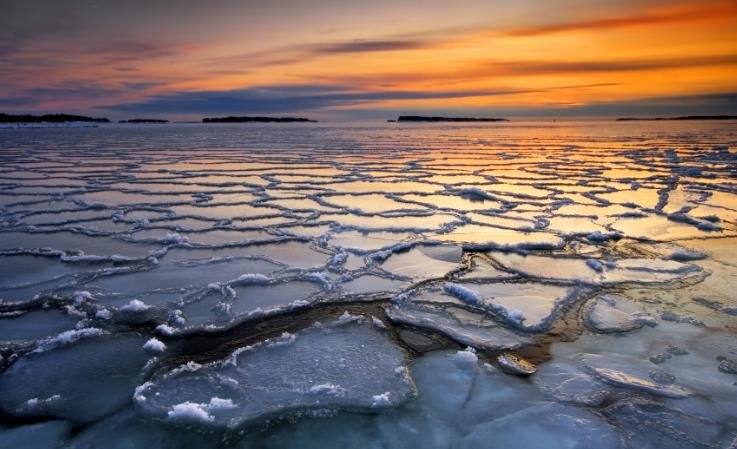Antarctic sea ice algae are microscopic organisms that live in pockets of salty brine under the frozen surface of the Southern Ocean. They are vital for supporting marine life and regulating the climate. A new study reveals how they adjust to the unusual seasonal cycles of light and temperature in this remote environment.
Sea ice algae: The hidden photosynthesizers
Sea ice algae are single-celled organisms that perform photosynthesis, converting light energy into chemical energy and producing oxygen as a byproduct. They are the primary producers of organic matter in polar regions, forming the base of the food web for larger animals such as krill, fish, penguins and whales.

Sea ice algae also play an important role in the global carbon cycle, absorbing carbon dioxide from the atmosphere and storing it in organic molecules. Some of these molecules are sulfur-containing compounds that give beaches their distinctive smell and can influence cloud formation when released into the air by sea spray.
Sea ice algae are adapted to live in extreme conditions of low light, low temperature and high salinity. They can survive in pockets of brine that are up to 10 times saltier than seawater and remain liquid even at -20°C.
Seasonal rhythms of Antarctic sea ice
The Antarctic sea ice cover undergoes dramatic changes throughout the year, expanding and contracting with the seasons. In winter, from March to October, the sun barely rises above the horizon and seawater freezes over a large area around the continent. As seawater freezes, it rejects salts, creating pockets of extra-salty brine where sea ice algae live.
In summer, from November to February, the sun stays up for 24 hours a day and melts most of the sea ice, producing warmer and fresher water at the surface. This creates favorable conditions for phytoplankton, microscopic algae that float freely in the water column.
The seasonal cycle of sea ice affects not only the physical environment but also the biological activity of sea ice algae and phytoplankton. Previous studies have shown that sea ice algae bloom in spring when light levels increase, while phytoplankton bloom in summer when nutrients are abundant.
However, little is known about how sea ice algae respond to changes in salinity and temperature throughout the year, and what molecules they produce and use to cope with these fluctuations.
A new study sheds light on sea ice algae metabolism
A new study by researchers from the University of Washington provides the first measurements of how sea ice algae adjust their metabolism to the seasonal rhythms of light and temperature in Antarctica.
The study was published on September 15, 2023 in ISME Journal, a journal of microbial ecology.
The researchers collected samples of sea ice cores from two locations near Antarctica: McMurdo Sound and Terra Nova Bay. They analyzed the samples for various parameters such as salinity, temperature, chlorophyll (a pigment that indicates algal biomass), dissolved organic carbon (a measure of organic matter production) and metabolites (molecules involved in metabolic reactions).
They found that sea ice algae had different metabolic profiles depending on the season and location. In winter, they produced more molecules related to stress response, such as osmolytes (compounds that help balance water and salt levels) and antioxidants (compounds that protect against oxidative damage). In summer, they produced more molecules related to growth and energy production, such as sugars, amino acids and lipids.
They also found that sea ice algae had different metabolic profiles depending on the location. In McMurdo Sound, where the sea ice was thicker and more stable, they produced more molecules related to carbon storage, such as polysaccharides (complex sugars) and dimethylsulfoniopropionate (DMSP, a sulfur-containing compound that can be converted into dimethyl sulfide, a gas that affects cloud formation). In Terra Nova Bay, where the sea ice was thinner and more dynamic, they produced more molecules related to carbon consumption, such as organic acids and glycerol (simple sugars).
The researchers suggest that these differences reflect the different strategies of sea ice algae to cope with the varying environmental conditions. In McMurdo Sound, where light and nutrient availability are low, sea ice algae store carbon for future use and produce DMSP to protect themselves from predators and stress. In Terra Nova Bay, where light and nutrient availability are high, sea ice algae consume carbon for immediate growth and produce organic acids and glycerol to regulate their osmotic pressure and membrane fluidity.
Implications for polar ecosystems and climate change
The study provides new insights into the metabolic diversity and flexibility of sea ice algae in Antarctica. It shows how they adapt to the unusual seasonal cycles of light and temperature in this remote ecosystem.
The study also has implications for understanding the role of sea ice algae in polar ecosystems and climate change. Sea ice algae are important sources of food and carbon for higher trophic levels, such as krill and fish. They also influence the biogeochemical cycles of carbon and sulfur, which affect the ocean acidification and cloud formation.
However, Antarctic sea ice is undergoing rapid changes due to global warming. The extent, thickness and duration of sea ice are decreasing, altering the physical and biological environment for sea ice algae. How sea ice algae will respond to these changes and how they will affect the polar ecosystems and climate are open questions that require further research.
